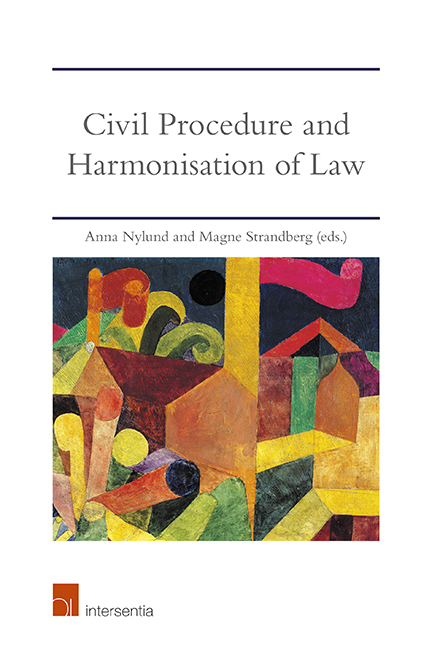Book contents
- Frontmatter
- Preface
- Contents
- List of Contributors
- List of Abbreviations
- Introduction
- EU Civil Justice at the Harmonisation Crossroads?
- The ELI-UNIDROIT Project: An Introduction and an English Perspective
- Europeanisation of Civil Procedure: Overcoming Follow-Up Fragmentation through Bottom-Up Harmonisation?
- Harmonisation or Fragmentation of National Law? An East Nordic Perspective
- An Examination of the Influence of European Union Law on English Civil Procedure
- The EU's Influence on Norwegian Civil Procedure through National Substantive Law
- Consumer Protection and EU-Driven Judicial Activism in the Netherlands
- The Role of the Judge in Consumer Cases – A German Perspective
- Ex Officio Application of the Unfair Terms Directive Cases against Consumers: A Swedish Perspective
- Ex Officio Application of EU Consumer Protection Law in Norwegian Courts
- Maintenance and Multi-Level Harmonisation: A European Union Perspective
- Family Maintenance and Multi-Speed Integration: A Norwegian Perspective
- Conclusions on Civil Procedure and Harmonisation of Law
- About the Editors
Introduction
Published online by Cambridge University Press: 30 March 2019
- Frontmatter
- Preface
- Contents
- List of Contributors
- List of Abbreviations
- Introduction
- EU Civil Justice at the Harmonisation Crossroads?
- The ELI-UNIDROIT Project: An Introduction and an English Perspective
- Europeanisation of Civil Procedure: Overcoming Follow-Up Fragmentation through Bottom-Up Harmonisation?
- Harmonisation or Fragmentation of National Law? An East Nordic Perspective
- An Examination of the Influence of European Union Law on English Civil Procedure
- The EU's Influence on Norwegian Civil Procedure through National Substantive Law
- Consumer Protection and EU-Driven Judicial Activism in the Netherlands
- The Role of the Judge in Consumer Cases – A German Perspective
- Ex Officio Application of the Unfair Terms Directive Cases against Consumers: A Swedish Perspective
- Ex Officio Application of EU Consumer Protection Law in Norwegian Courts
- Maintenance and Multi-Level Harmonisation: A European Union Perspective
- Family Maintenance and Multi-Speed Integration: A Norwegian Perspective
- Conclusions on Civil Procedure and Harmonisation of Law
- About the Editors
Summary
MULTIPLE LEVELS OF INTERNATIONAL RULES ON CIVIL PROCEDURE
Although civil procedure law has been traditionally considered to be deeply embedded in national (legal) culture and thus resistant to harmonisation, legislative efforts over the last few decades have given rise to a growing international influence on national civil procedure. While civil procedure law in the nineteenth and twentieth centuries was not free from foreign influences, ideas were mainly transferred from one country to another and not from international law to national law. Although the Brussels Convention of 1968 and the European Convention on Human Rights of 1950 marked the early emergence of supranational law of civil procedure, the momentum for extensive regulation was gained only at the turn of the millennium. Today, supranational and international influence on national civil procedure emanates from multiple sources, both binding and non-binding.
During the last couple of decades, a body of international instruments concerning civil procedure has emerged. Most of these emanate from the European Union (EU), but other institutions, such as the United Nations, the European Council, The Hague Conference on Private International Law and UNIDROIT, are also of importance. The current situation regarding international legal sources on civil procedure is rather complex and not easily comprehensible, but we can identify a number of categories or levels into which most of the international rules on civil procedure law should fit:
– basic human rights;
– general principles of EU law;
– EU secondary law;
– international conventions or treaties on legal co-operation; and
– soft law.
As the first category, at both an overarching and a deep level, we find basic human rights. From the perspective of civil procedure law, the most important human rights are the right to a fair and public hearing found in Article 6 of the European Convention on Human Rights (ECHR), Article 14 of the UN Covenant on Civil and Political Rights, and Article 47 of the European Charter of Fundamental Rights. However, civil procedure law is also infl uenced by other human rights, such as the right to respect for privacy and family life found in Article 8 ECHR and the right to an effective remedy found in Article 13 ECHR.
- Type
- Chapter
- Information
- Civil Procedure and Harmonisation of LawThe Dynamics of EU and International Treaties, pp. 1 - 10Publisher: IntersentiaPrint publication year: 2019



